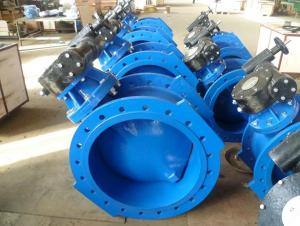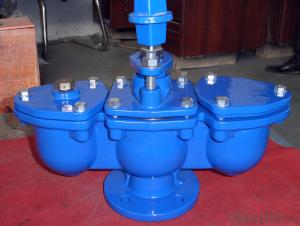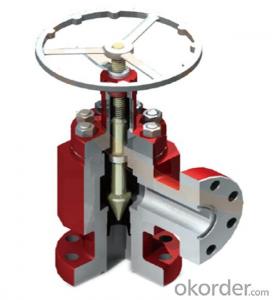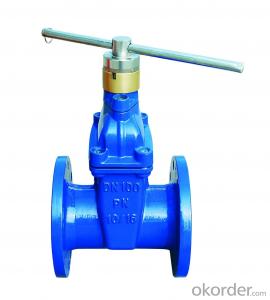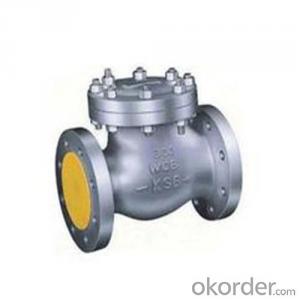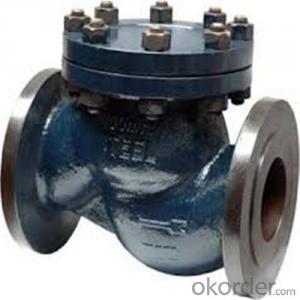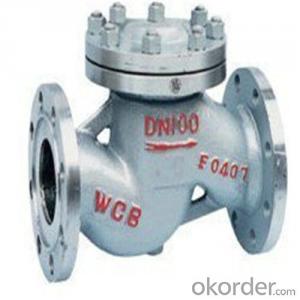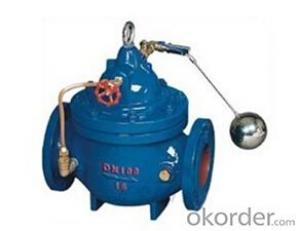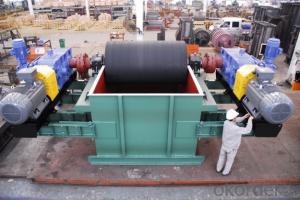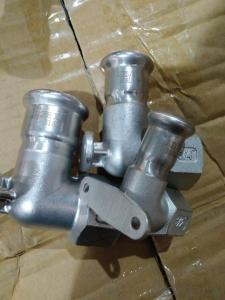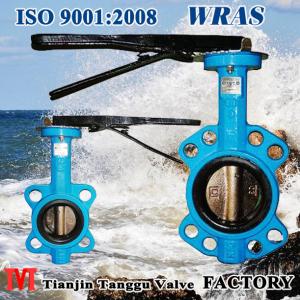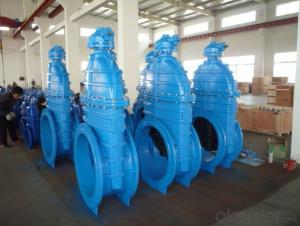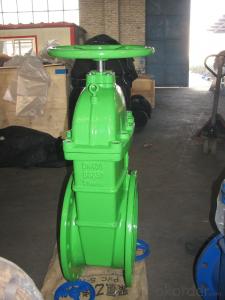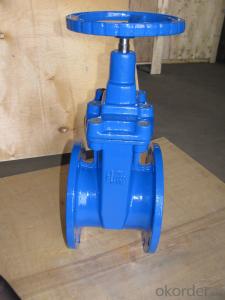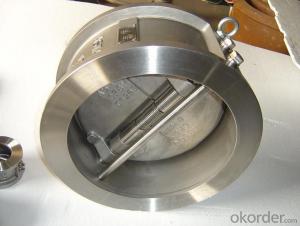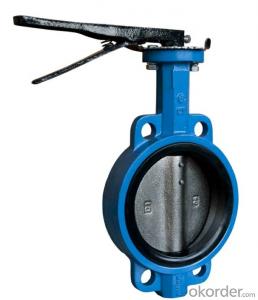Double flanged Metal Seal eccentric butterfly valve
- Loading Port:
- China Main Port
- Payment Terms:
- TT OR LC
- Min Order Qty:
- -
- Supply Capability:
- -
OKorder Service Pledge
OKorder Financial Service
You Might Also Like
Specifications
Double flanged Double Eccentric Butterfly Valve
PN10/16/25
DN100 ~ DN2000
Technical Specifications
- Design and manufacture: EN593, EN1074-1 and 2
- Face to face dimension: EN558-1 Series 14 (DIN3202 F4)
EN558-1 Series 13 (BS5163)
- Flange dimensions and drillling: EN1092-2 PN10/16/25
- Size range: DN100 - DN2000
- Max. working pressure: 1.0/1.6/2.5 MPa
- Inspection test: EN12266
- Working temperature: -15°C to +80°C
- Suitable medium: water
Main Fetures
- Double eccentric disc reduces seal wear and torque
- Body seat ring is welded directly on the body
- Bi-directional flow and low head loss
- Disc sealing ring to be replaceable on pipeline without dismantling the valve
- Body and disc inside and outside epoxy powder coated (min. 250 microns)
- Opening and closing indicators are provided
- Coupling flange for electric actuator in compliance with ISO5211
- Gearbox and electric actuator operation available
Main Parts and Materials
Body and disc: ductile iron EN GJS500-7/400-15
Shafts: stainless steel AISI 420
Body seat ring: stainless steel AISI 304
Disc sealing ring: EPDM or NBR
Retaining ring: stainless steel or ductile iron
Shaft bearing: Du bushes (self lubricating bushes)
- Q:I have a trumpet, but unintentionally dropped it. When I started playing, I noticed that the first valve was very sticky. Therefore, I decided to put some oil on it. Despite the oil helping a lot, the valves are still sticking a bit when I push them down, as the key still stays in the valve for a few second before coming up again. It could possibly have a slight dent, but when I opened the valve, I did not see any damage at all. Are there any suggestions? And if it is dented how much would it cost to repair it?
- I would wager there is no dent, but the valves aren't quite straight. They have to be straight. Don't know what it will cost to fix, they may have to be replaced.
- Q:My doctor detectd a heart mumer. I am 48 years old. Had a echocardiogram performed. He says that I have a sightly irregular valve and I do not need to take precautions. I run three miles a day. I have heard that this condition makes your heart more suceptiable to infection. You should take antibiotics when dental work is done. My GP is a man of few words. Just says continue as usual and nothing needs to be done unless there is further symptomns. My question: Should I follow up with a heart specialist or would it be over doing it? Should I go on antibiotics when I get dental work? Can this Slightely irregular valve get worse?
- Actually this is quite common and is usually not a concern. It is generally felt that the misshapen valve leaves you more open to potential infection, especially when having dental work done. But this is quite rare. Still, if the dentist knows you have the condition they will require you to take a loading dose of antibiotics to protect yourself when you have any work done. Occasionaly I would forget and they would send me home. Geeze. Still, better safe than sorry. In the big scheme of things it means very, very little and you will probably never know its there. There is no need to see a specialist, again, this is very common and very, very rarely causes any problems. Just keep on keeping on and you will be fine. Just consider the antibiotics pre-dental work. All you have to do is call the doctors office, tell them you need some for a dental visit, they will fax over a script to the pharmacy, you pick it up, eat something first, then take the antibiotics and you are done, no big deal. I hope this helps.
- Q:After shutting off the hot and cold water lines to my washer to remove the unit from my laundry room i noticed a small leak coming from the hot water valve as if the valve is not completely closing. The valves themselves should be roughly 10 years old and were extremely tight when attempting to close them, my question is how big of a job is this to replace the water valve? Is it as simple as turning off the main water to the house and replacing the valve or are these typically soldered on? Currently i just ran the hose for the hot water to the drain line to prevent water from leaking onto the floor so is this something that is a fairly non issue once i hook the lines back up to the washer and turn them back on? Or is this something i should get addressed asap?
- Not to sound insulting but the hose will have water left in after you turn the valve off , use a bucket and drain the house before you go tearing things apart. You really do not have to change the whole valve if that is the case, there is a rubber washer inside of the valve which may be worn or distorted from over tightening of the valve.Either way you have to drain the system I would tell you to attend one of the plumbing classes at Home depot to learn what to do they hold them all of the time .
- Q:Hi. I am planning to install new kitchen faucet and noticed that there are two shut off valves under the sink. One of them is badly rusted and needs to be replaced. I noticed that it is connected to three pipes (one of which is kitchen faucet). The other is clearly water coming in. What is the third one connected to wall? Also how should I go about replacing this? Anything that I should be careful of? Thank you.Here's picture of shutoff valve.
- You can install a pullout kitchen sink faucet on a wide variety of sinks. There are many options, but the same is not true for the other type of faucet sprayer: A spout sprayer. Let's say you have a old sink to work with. You're probably going to be able to install a pullout sprayer with little problems. You probably won't be able to do the same with a faucet sprayer built in to the spout on an older sink though. These are excellent when you want to spray and wash your vegetables. When you hold your vegetables under a typical faucet, you have to roll them around with your hands in order to loosen any dirt or other contaminants. The sprayer works like a mini hose and can do that work for you.
- Q:Anyone know how to stop this from happening? I have gone through 4 since March.
- are you sure its the egr valves going bad or not the egr solenoids causing you to get the code,that will make it appear that an egr has gone bad when it really hasn't,good luck.
- Q:I need to make a one way valve that would allow water or other fluid one way but if there is too much pressure on the opposite side the valve will close and stop water from flowing backward. Can anyone help?
- You are looking for whats called an RP or back flow device. These may be sold at home depot. However, I know your local plumbing supply house would carry them.
- Q:HI ever one i have a 1969 1500 beetle engine i have just but 1600 piston and barrows on it but when i but the rockers on i have no valve gap at all. ive wound out the adjusters all the way and i still can not get a feeler gauge between the rocker and the valve. Please help cheers Adam
- you MUST have the cylinder you are adjusting at TDC before adjusting the valves on that cylinder. take the dizzy cap off and rotate the engine clock-wise until the the rotor is pointing toward the #1 cylinder (the front at about 5 o'clock where the little notch in the case of the dizzy is) there is also a little V shaped notch in the crank pulley. this has to be aligned with the crack in the case at the top of the pulley. then take the valve cover off the right side of the motor and adjust the 2 valves toward the front of the engine (front is front of car) these are the intake and exhaust valves for the #1 cylinder. after you get them gaped to .006 snug the jam nut down. then rotate the crank EXACTLY 180 degrees counter-clockwise this will get you to TDC for #2. then adjust the back 2 valves on the right side of the motor (back is back of car) these are valves for #2 cylinder. then put the valve cover back on. rotate the engine another 180 degrees counter-clockwise, this will give you TDC for #3 which is the front left of the motor. adjust them and rotate the crank another and final 180 degrees counter-clockwise for #4 cylinder put the valve cover back on with new gaskets of course and you are done
- Q:If you suffer from Heart Valve Disease why do you get tired or struggle breathing?
- There are four valves in the heart. (Bicupid valve and aortic valve in the left side and tricuspid valve and pulmonary valve in the right side). You have not stated which valve is affected. Valvular heart disease may cause shortness of breath (dyspnea) and heart palpitations. You may need surgery if your valve does not work properly. * A valve that does not close all the way will allow blood to leak backwards. This is called regurgitation. * A valve that does not open fully will restrict blood flow. This is called stenosis.
- Q:I'm at school reading a mag and all the internet is blocked except yahoo. So i'm trying to figure out what the diff is between 3 angle versus 5 angle valve jobs.
- The object of the valve angles is to produce a smooth transition to help air flow. So a 5 angle valve job is done to make a series of angles that are closer to a even radius or even parabolic. For street use, you not see that much difference. But when you are at the top levels of competition that little bit might be the difference between an also ran and a winner (read winnings).
- Q:1990 5.7l with a .470 lift cam , is there going to be a clearance issue between the valve guide and the valve. Is the rocker going to bottom out on the guides and bust my heads.. If so what should i do.
- Get yourself a degree wheel and check. A valve stem usually has about 1-1/2 thousandths of an inch of clearance between it and the guide to allow movement and lubrication. Your camshaft has no bearing on this clearance. If you want a wild guess as to whether or not you might get coil bind in the springs, rocker bind against the rocker stud or even valve spring retainer smashing into the top of the valve seal then my guess is not, not with just .470 lift. Probably would take more like .500 for any of that to happen.
1. Manufacturer Overview |
|
|---|---|
| Location | |
| Year Established | |
| Annual Output Value | |
| Main Markets | |
| Company Certifications | |
2. Manufacturer Certificates |
|
|---|---|
| a) Certification Name | |
| Range | |
| Reference | |
| Validity Period | |
3. Manufacturer Capability |
|
|---|---|
| a)Trade Capacity | |
| Nearest Port | |
| Export Percentage | |
| No.of Employees in Trade Department | |
| Language Spoken: | |
| b)Factory Information | |
| Factory Size: | |
| No. of Production Lines | |
| Contract Manufacturing | |
| Product Price Range | |
Send your message to us
Double flanged Metal Seal eccentric butterfly valve
- Loading Port:
- China Main Port
- Payment Terms:
- TT OR LC
- Min Order Qty:
- -
- Supply Capability:
- -
OKorder Service Pledge
OKorder Financial Service
Similar products
New products
Hot products
Related keywords


